**”The Powerhouses of the Hunt: Exploring the Majestic Large Hunting Dog Breeds”**
** Introduction to large hunting dog breeds **
When it comes to hunting, having the right companion with you can make a big difference, and this is where large hunting dog breeds come in handy. These dogs are powerhouses of the hunting world, combining strength, stamina, and intelligence to excel in the field. Be it tracking game through dense forests or retrieving waterfowl from icy lakes, these breeds are built for the job.
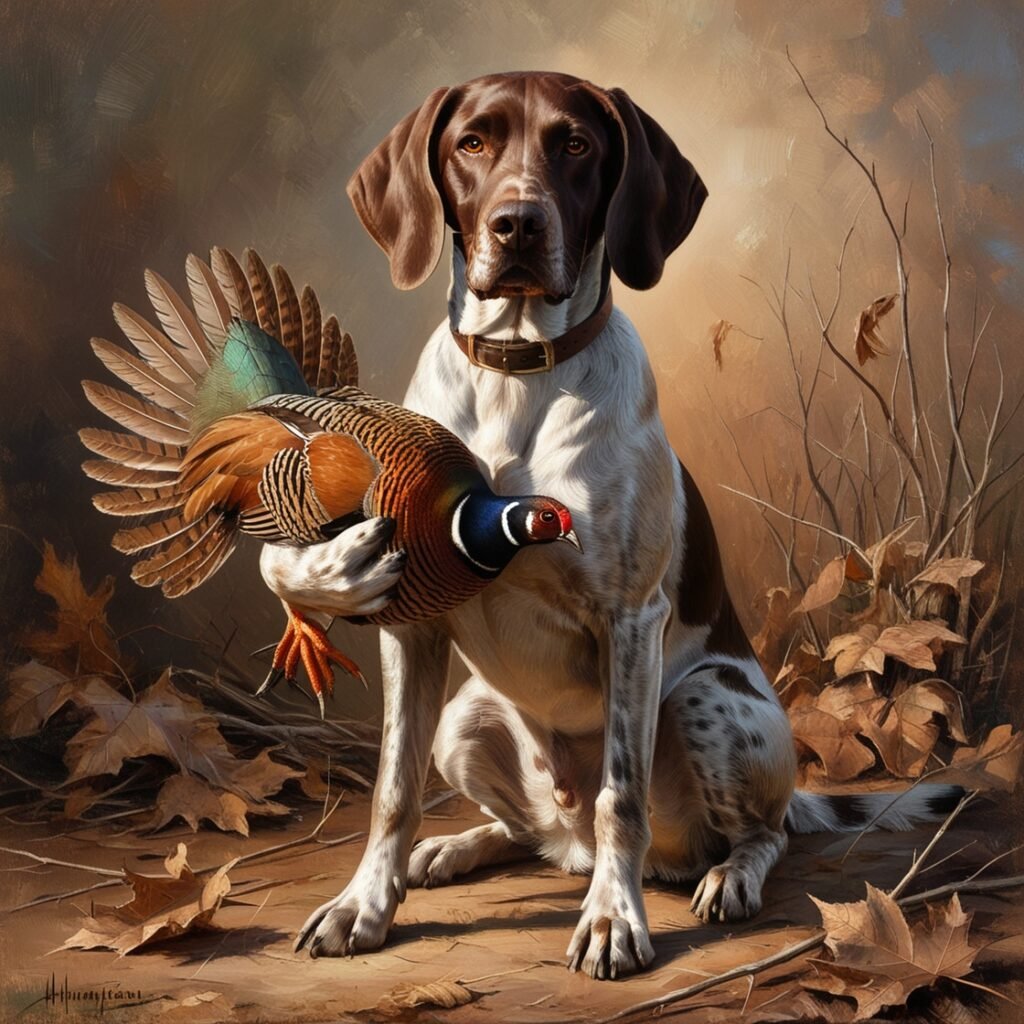
Large hunting dog breeds
Large hunting dog breeds such as the Labrador Retriever, Weimaraner and Bloodhound have been bred for centuries to assist hunters in a variety of terrain and conditions. Their size isn’t just for show – it’s essential to the tough tasks they perform. These dogs have an incredible desire to work, as well as natural instincts that make them exceptional hunting partners.
But their abilities are not limited to hunting. Many of these breeds are also known for their loyalty and gentle temperament, making them great family pets as well. Whether you’re an avid hunter or simply love the idea of owning a dog that embodies strength and dedication, large hunting dog breeds offer a unique combination of work ethic and companionship that is difficult to find elsewhere.
Popular 15 Large Hunting Dog Breeds ;
1. Labrador Retriever
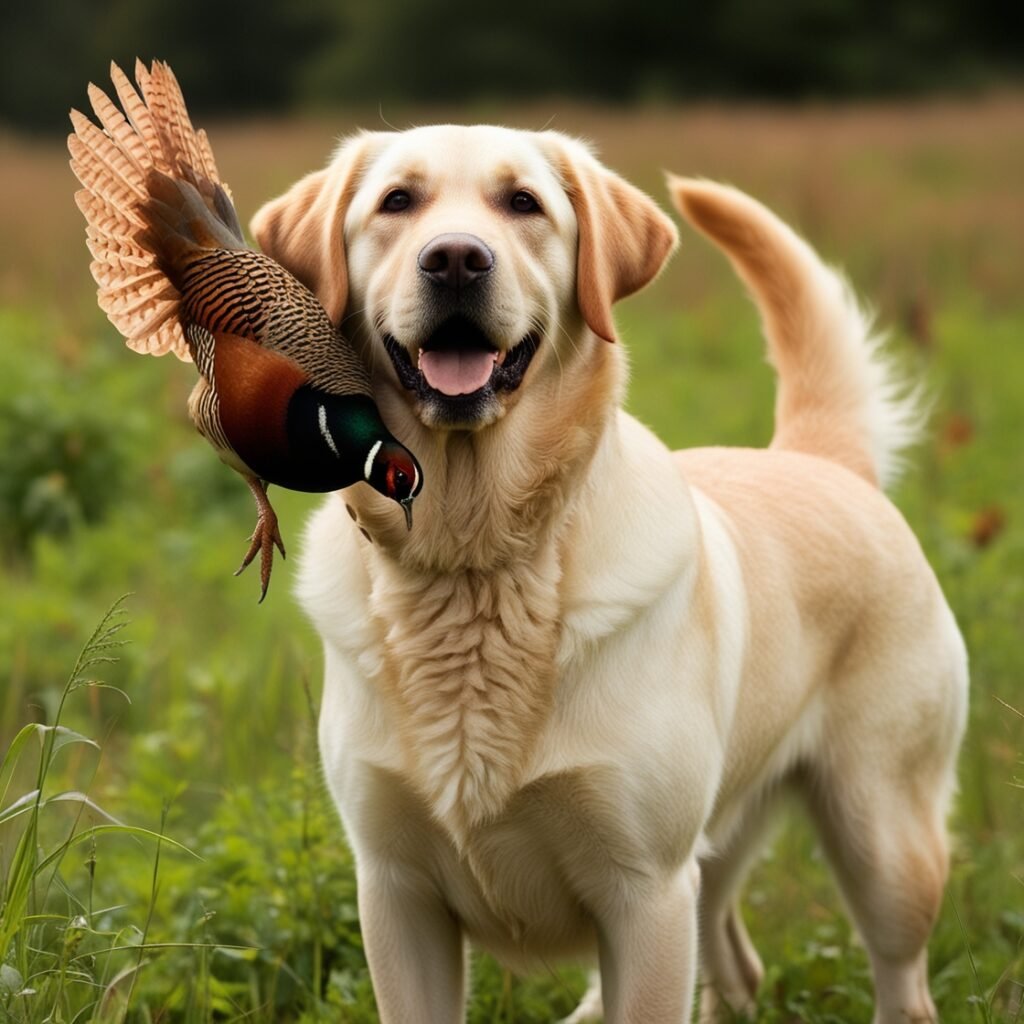
- Height:
- Male: 22.5 to 24.5 inches
- Female: 21.5 to 23.5 inches
- Weight:
- Male: 65 to 80 pounds
- Female: 55 to 70 pounds
- Color:
- Black, yellow, chocolate
- Temperament:
- Friendly, outgoing, and eager to please
- Hunting Skills and Abilities:
- Excellent at retrieving game, especially in water; strong swimmer
- Speed and Agility:
- Quick and agile, making them efficient both on land and in water
- Origin and History:
- It originated in Newfoundland, Canada, where they helped fishermen net and fish. This breed was later refined in England to become the popular hunting and family dog we know today.
2. German Shorthaired Pointer
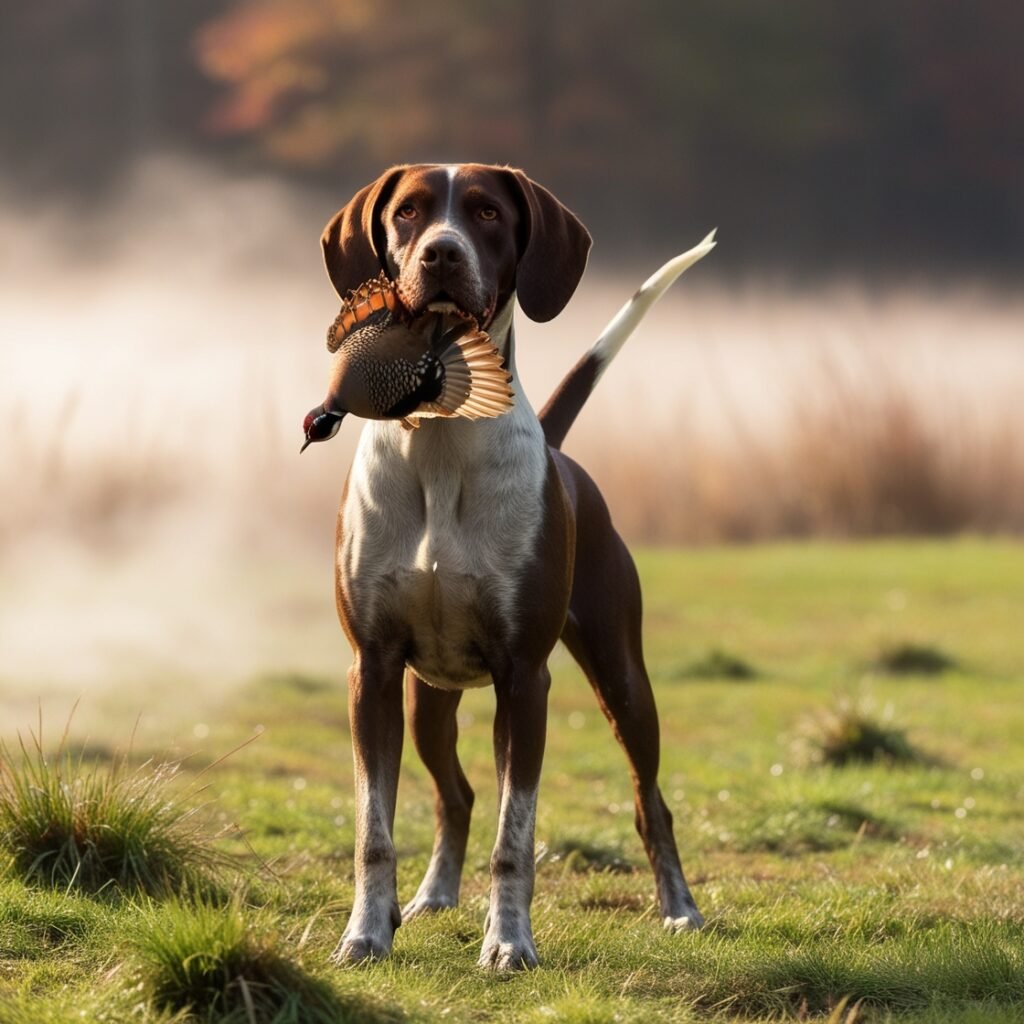
- Height:
- Male: 23 to 25 inches
- Female: 21 to 23 inches
- Weight:
- Male: 55 to 70 pounds
- Female: 45 to 60 pounds
- Color:
- Liver (brown), liver and white, or liver roan (mix of liver and white)
- Temperament:
- Energetic, intelligent, and eager to work
- Hunting Skills and Abilities:
- Versatile hunter, skilled in pointing, retrieving, and tracking on land and in water
- Speed and Agility:
- Fast and agile, with excellent endurance for long hunts
- Origin and History:
- Originating in 19th century Germany, it was bred to be an all-purpose hunting dog that could handle a variety of game and terrain. Developed from a mixture of Spanish Pointers, German Scent Hounds, and other breeds to create a versatile and reliable hunting companion.
3. Weimaraner
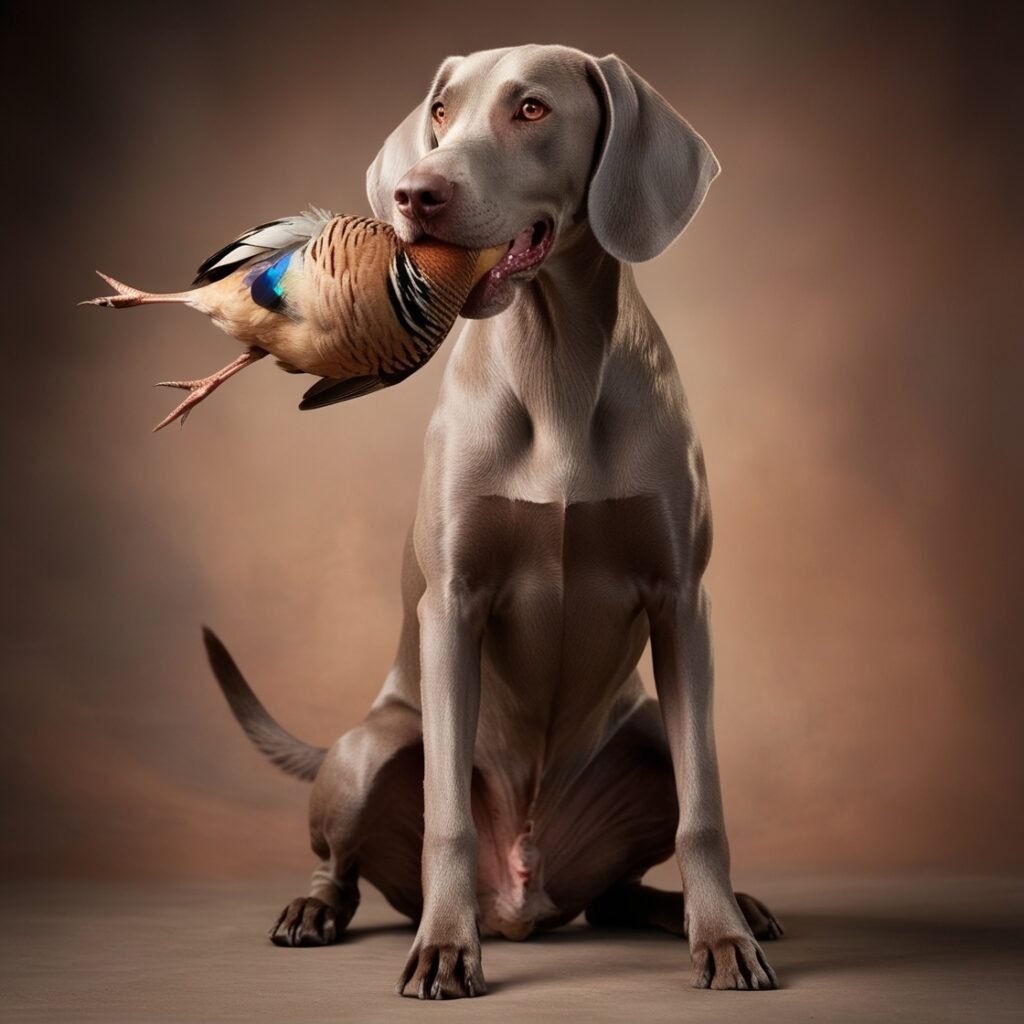
- Height:
- Male: 25 to 27 inches
- Female: 23 to 25 inches
- Weight:
- Male: 70 to 90 pounds
- Female: 55 to 75 pounds
- Color:
- Silver-gray
- Temperament:
- Energetic, loyal, and intelligent
- Hunting Skills and Abilities:
- Excellent at tracking and hunting large game like deer and boar; also skilled in bird hunting
- Speed and Agility:
- Very fast and agile, with great stamina for long hunts
- Origin and History:
- Originating in Germany in the early 19th century, bred by aristocrats for hunting large game. This breed was developed from the Bloodhound and other hunting dogs to create a strong, versatile hunter. Today, the Weimaraner is valued for both its hunting skills and as a loyal family companion.
4. Bloodhound
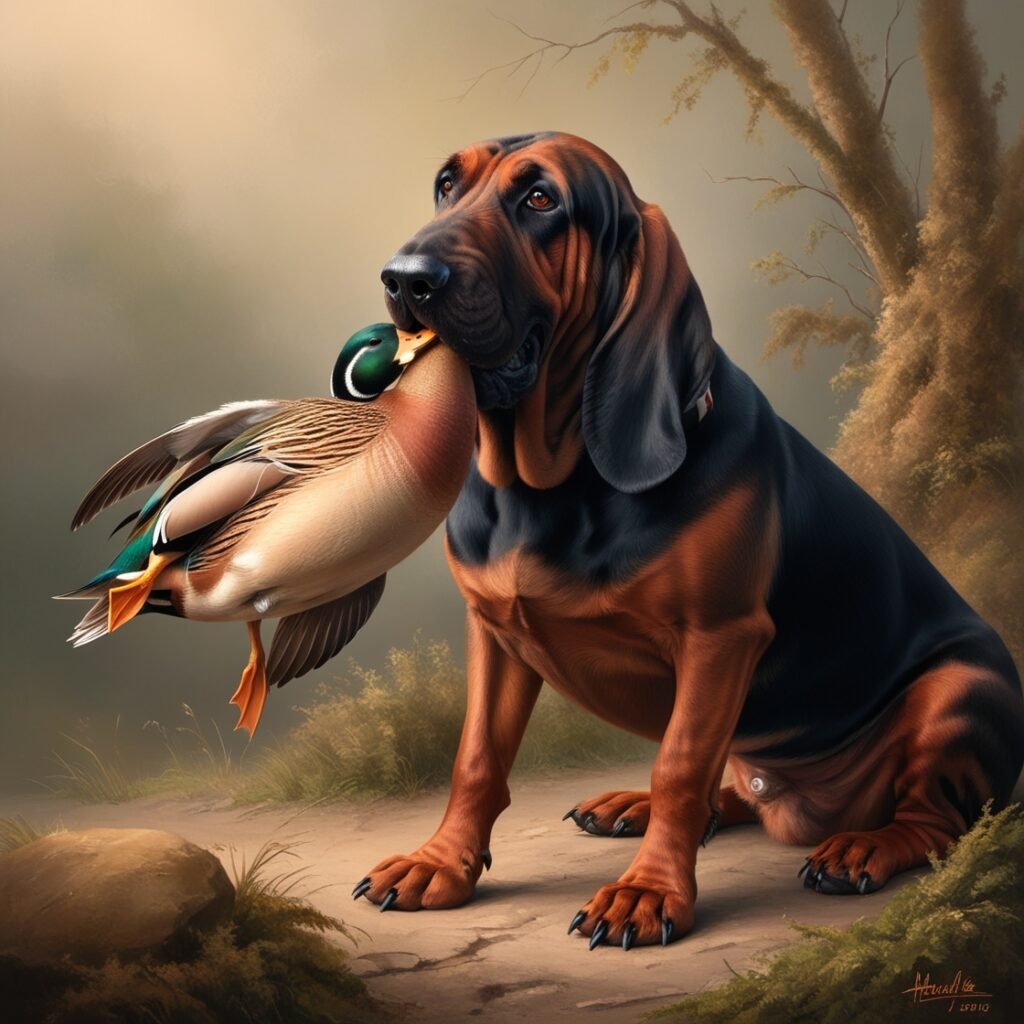
- Height:
- Male: 25 to 27 inches
- Female: 23 to 25 inches
- Weight:
- Male: 90 to 110 pounds
- Female: 80 to 100 pounds
- Color:
- Black and tan, liver and tan, or red
- Temperament:
- Gentle, patient, and determined
- Hunting Skills and Abilities:
- Exceptional at scent tracking, known for following trails over long distances with incredible accuracy
- Speed and Agility:
- Not particularly fast, but highly persistent and able to follow a scent for hours or even days
- Origin and History:
- Originating in France or Belgium around the Middle Ages, developed by monks for tracking and hunting. Bloodhounds were later refined in England and became famous for their unmatched scent-tracking abilities, often used in search and rescue and law enforcement. Even today, they are prized for their tracking skills and gentle nature.
5. Chesapeake Bay Retriever
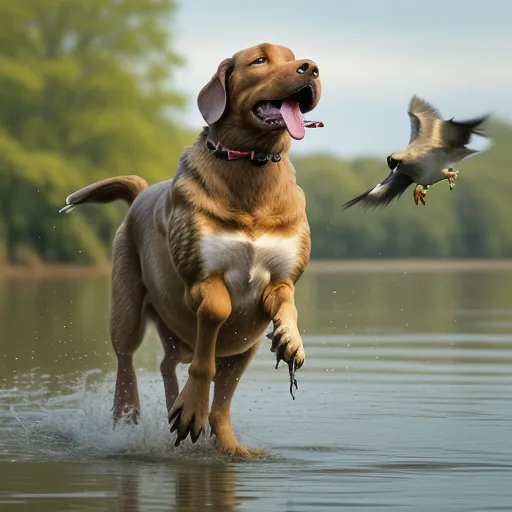
- Height:
- Male: 23 to 26 inches
- Female: 21 to 24 inches
- Weight:
- Male: 65 to 80 pounds
- Female: 55 to 70 pounds
- Color:
- Brown, sedge (reddish-brown), or deadgrass (straw-colored)
- Temperament:
- Loyal, intelligent, and protective
- Hunting Skills and Abilities:
- Excellent at retrieving waterfowl, especially in cold and rough water; strong swimmer with a natural love for water
- Speed and Agility:
- Fast and powerful, with great endurance for long hunts in tough conditions
- Origin and History:
- It originated in the Chesapeake Bay region of the United States in the 1800s. Bred from Newfoundlands and other water dogs, they were developed to retrieve ducks from the icy waters of the Chesapeake Bay. Known for their hardiness and determination, they are still a favorite among waterfowl hunters and are loyal family pets.
6. English Foxhound
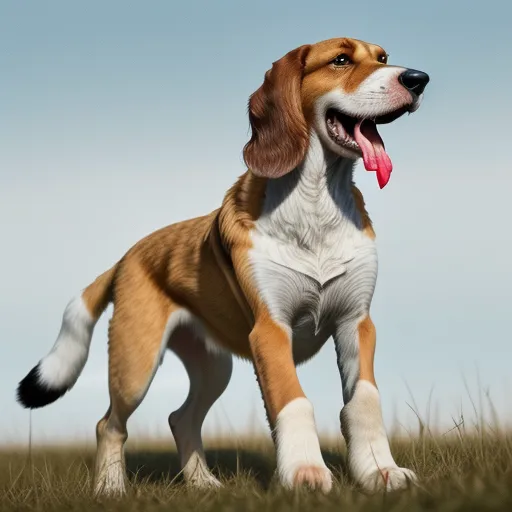
- Height:
- Male: 24 to 27 inches
- Female: 23 to 26 inches
- Weight:
- Male: 65 to 75 pounds
- Female: 60 to 70 pounds
- Color:
- White with black, tan, or cream markings
- Temperament:
- Friendly, energetic, and determined
- Hunting Skills and Abilities:
- Excellent pack hunter, especially for tracking and chasing foxes; strong sense of smell and stamina
- Speed and Agility:
- Very fast and agile, with the endurance to run for long distances
- Origin and History:
- Originating in England in the 1600s, bred specifically for fox hunting. Developed by crossing various hunting dogs, the English Foxhound became a major player in traditional British fox hunting. Known for their ability to work well in herds and their tireless energy, they are still used in hunting today and are also valued as companion animals.
7. Rhodesian Ridgeback
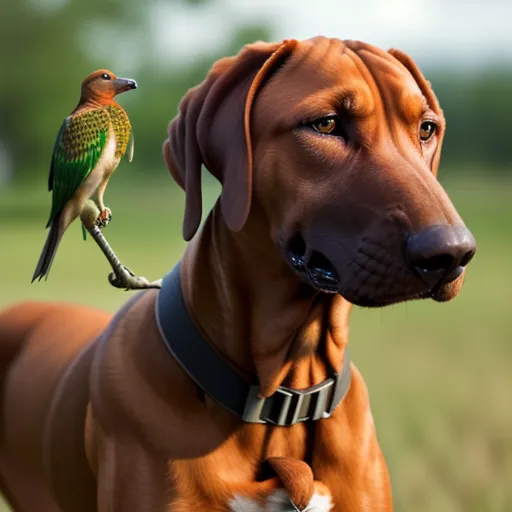
- Height:
- Male: 25 to 27 inches
- Female: 24 to 26 inches
- Weight:
- Male: 85 pounds
- Female: 70 pounds
- Color:
- Light wheaten to red wheaten
- Temperament:
- Loyal, independent, and courageous
- Hunting Skills and Abilities:
- Originally bred for hunting lions, with strong tracking abilities and the courage to face large game
- Speed and Agility:
- Fast and powerful, with great endurance, able to cover long distances with ease
- Origin and History:
- It originated in Southern Africa, specifically Zimbabwe (formerly Rhodesia), in the late 19th century. Developed by crossing local Khoikhoi dogs with European breeds such as the Great Dane and Greyhound, the Rhodesian Ridgeback was bred to be a versatile hunter, protector, and family companion. The distinctive series of hairs on its back give the breed its name. Today, it is known for its loyalty and strong hunting instincts.
8. Irish Setter
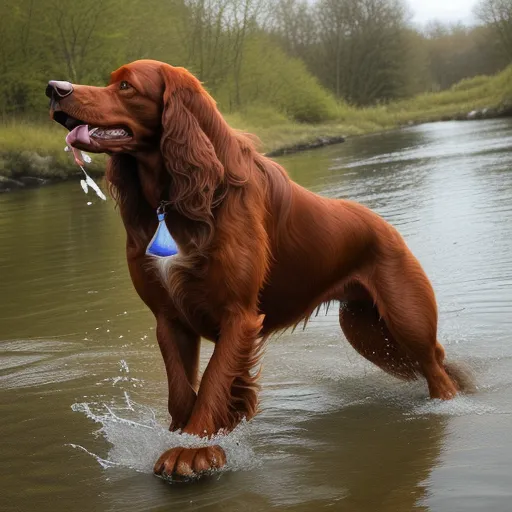
- Height:
- Male: 27 inches
- Female: 25 inches
- Weight:
- Male: 70 pounds
- Female: 60 pounds
- Color:
- Mahogany or chestnut red
- Temperament:
- Friendly, outgoing, and energetic
- Hunting Skills and Abilities:
- Excellent bird hunter, particularly skilled in pointing and retrieving game birds like pheasants and quail
- Speed and Agility:
- Fast and graceful, with a high level of endurance for covering large areas during hunts
- Origin and History:
- Originating in Ireland in the 18th century, it was developed by crossing several breeds including spaniels, pointers, and other setters. Bred specifically for hunting birds in the Irish countryside, the Irish Setter quickly became known for its attractive red coat and excellent hunting abilities. Today, they are beloved for their friendly nature and beautiful appearance, making them popular as both hunting dogs and family pets.
9. American Foxhound
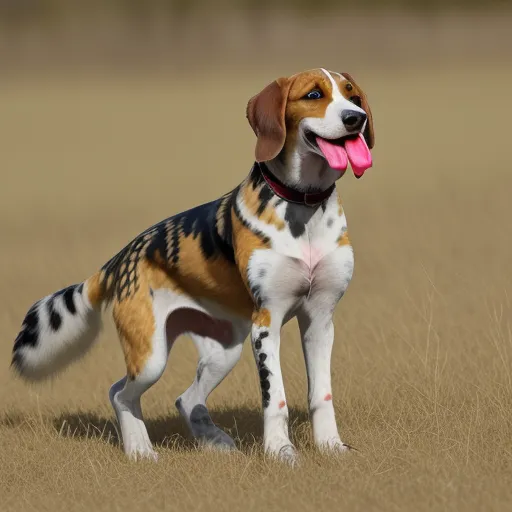
- Height:
- Male: 22 to 25 inches
- Female: 21 to 24 inches
- Weight:
- Male: 65 to 70 pounds
- Female: 60 to 65 pounds
- Color:
- Any color, typically a mix of white, black, and tan
- Temperament:
- Gentle, friendly, and independent
- Hunting Skills and Abilities:
- Exceptional at tracking and chasing foxes, with a keen sense of smell and strong stamina
- Speed and Agility:
- Very fast and agile, capable of running long distances during hunts
- Origin and History:
- Originating in the United States in the 1600s, developed from the English Foxhound brought to the colonies. Bred to be light and fast for hunting in the American landscape, the American Foxhound became a major player in fox hunting, especially in the Southern United States. Known for their musical performance and ability to work in packs, they remain popular as hunting and loyal companions.
10. Bluetick Coonhound
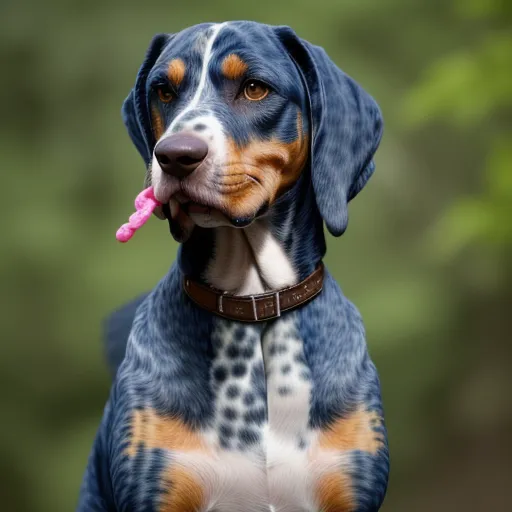
- Height:
- Male: 24 to 27 inches
- Female: 22 to 25 inches
- Weight:
- Male: 65 to 100 pounds
- Female: 45 to 75 pounds
- Color:
- Blue ticked with black and tan markings
- Temperament:
- Friendly, determined, and independent
- Hunting Skills and Abilities:
- Excellent at tracking and treeing raccoons and other small game; has a strong sense of smell and distinctive baying
- Speed and Agility:
- Fast and agile, with good endurance for tracking game over long distances
- Origin and History:
- Originating in the United States in the 19th century, it developed from a mixture of the English Coonhound and other breeds. Bred specifically for coon hunting, the Bluetick Coonhound was valued for its tracking abilities and stamina. Known for its attractive blue ticked coat and strong work ethic, it remains a favorite among hunters and is also appreciated as a loyal family companion.
11. Coonhound
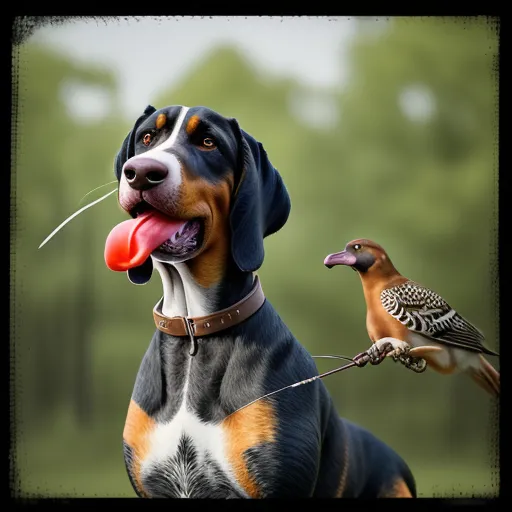
Note: The term “coonhound” can refer to several breeds, including black and tan, redbone, and others. Here’s a general overview:
- Height:
- Male: 24 to 27 inches
- Female: 22 to 25 inches
- Weight:
- Male: 65 to 100 pounds
- Female: 45 to 75 pounds
- Color:
- Black and tan, red, or a mix of these colors depending on the breed variant
- Temperament:
- Friendly, independent, and determined
- Hunting Skills and Abilities:
- Excellent at tracking raccoons and other small game and treeing; Known for its keen sense of smell and distinctive odor
- Speed and Agility:
- Fast and agile, with good endurance for long tracking sessions
- Origin and History:
- It originated in the United States, where various breeds of coonhound were developed for hunting raccoons and other game. Various hunting dog breeds were mixed and bred to create dogs with strong tracking abilities, stamina and a distinctive bay coat. Coonhounds have been popular with hunters for their effectiveness and are also appreciated as loyal pets.
12. Vizsla
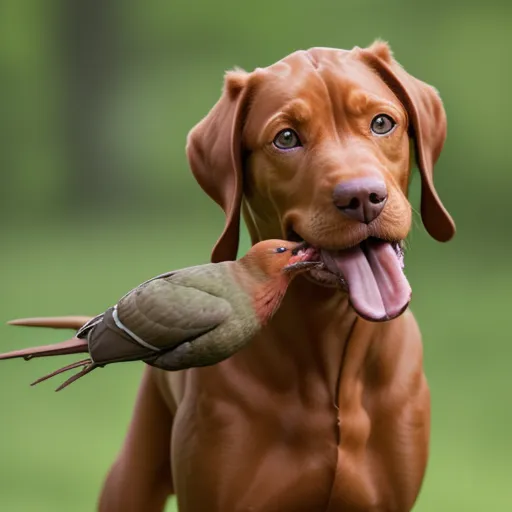
- Height:
- Male: 23 to 25 inches
- Female: 21 to 24 inches
- Weight:
- Male: 55 to 65 pounds
- Female: 45 to 55 pounds
- Color:
- Rusty gold, also known as golden rust
- Temperament:
- Friendly, energetic, and affectionate
- Hunting Skills and Abilities:
- Excellent at pinpointing and retrieving game birds; Versatile and works well on both land and water
- Speed and Agility:
- Fast and agile, with high endurance for long hunts
- Origin and History:
- They originated over a thousand years ago in Hungary, where they were bred to hunt birds of prey. The Vizsla was developed by mixing different hunting breeds to create a versatile and efficient hunter. Known for its loyalty and close bond with its owner, the Vizsla has been a popular choice for hunters and makes a beloved family pet.
13. Golden Retriever
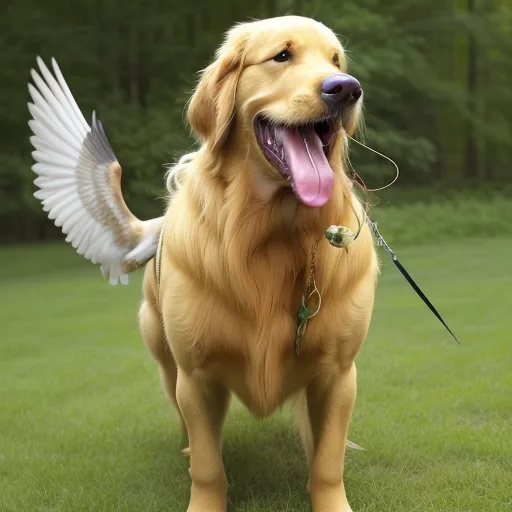
- Height:
- Male: 23 to 24 inches
- Female: 21.5 to 22.5 inches
- Weight:
- Male: 65 to 75 pounds
- Female: 55 to 65 pounds
- Color:
- Various shades of golden, from light to dark
- Temperament:
- Friendly, outgoing, and eager to please
- Hunting Skills and Abilities:
- Great at retrieving game, especially waterfowl; known for its soft mouth and reliable performance in the field
- Speed and Agility:
- Quick and agile, with good endurance for hunting and active play
- Origin and History:
- Originating in Scotland in the late 19th century, the Tweed Water Spaniel was developed by crossing retrievers with Bloodhounds and other breeds. The Golden Retriever was bred to retrieve prey from land and water. Known for its friendly nature and intelligence, it has become one of the most popular breeds as a hunting and family companion
14. English Setter
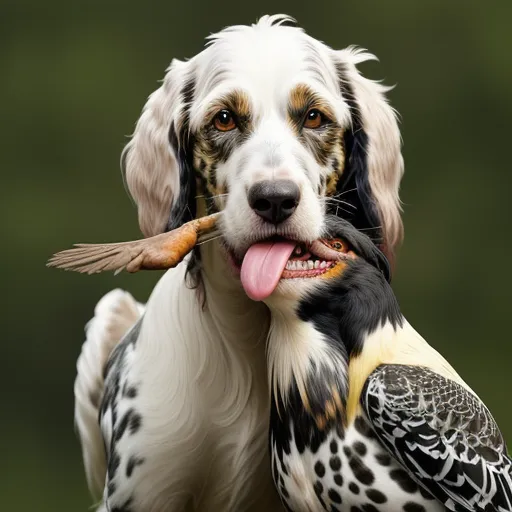
- Height:
- Male: 25 to 27 inches
- Female: 23 to 25 inches
- Weight:
- Male: 60 to 80 pounds
- Female: 45 to 65 pounds
- Color:
- Various combinations of white with black, orange, or liver (brown) markings
- Temperament:
- Gentle, friendly, and affectionate
- Hunting Skills and Abilities:
- Excellent at pointing and retrieving game birds, particularly in upland game; known for its keen nose and ability to cover large areas
- Speed and Agility:
- Graceful and fast, with good stamina for long days in the field
- Origin and History:
- Originating in England in the 19th century, it developed from a mixture of the Pointer and Spaniel breeds. The English Setter was bred to be a versatile bird dog with an excellent sense of smell and a calm demeanor. It quickly gained popularity due to its hunting skills and became a beloved companion both on the farm and in the home.
15. Curly-Coated Retriever
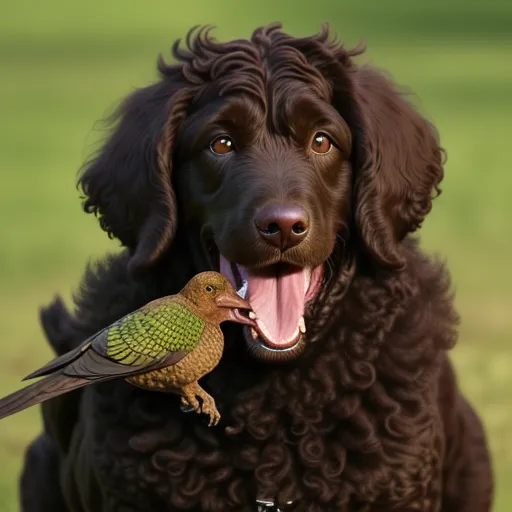
- Height:
- Male: 24 to 27 inches
- Female: 22 to 25 inches
- Weight:
- Male: 65 to 85 pounds
- Female: 55 to 75 pounds
- Color:
- Black or liver (dark brown)
- Temperament:
- Independent, intelligent, and friendly
- Hunting Skills and Abilities:
- Excellent at retrieving game from water and land; It is known for its strong swimming ability and distinctive curly coat that repels water.
- Speed and Agility:
- Agile and quick, with good stamina for long hunting sessions
- Origin and History:
- Originating in England in the 19th century, developed by crossing various retrievers and water dogs. The Curly-Coated Retriever was bred to retrieve waterfowl and other game, with its unique curly coat providing protection in wet conditions. It remains a valuable hunting dog and loyal family companion.
Characteristics of Large Hunting Dog Breeds ;
Large hunting dog breeds are known for their impressive size and unique characteristics that make them exceptional in the field. A key characteristic is their strong build, which gives them the strength and stamina needed to track and retrieve game over long distances. Their size often translates into greater stamina, allowing them to handle difficult terrain and extended hunting.
These breeds typically have a keen sense of smell, which is essential for tracking game, and their strong, agile bodies help them navigate a variety of environments, from dense forests to open fields. Many large hunting dogs, such as the Labrador Retriever and Weimaraner, are also excellent swimmers, making them ideal for catching waterfowl.
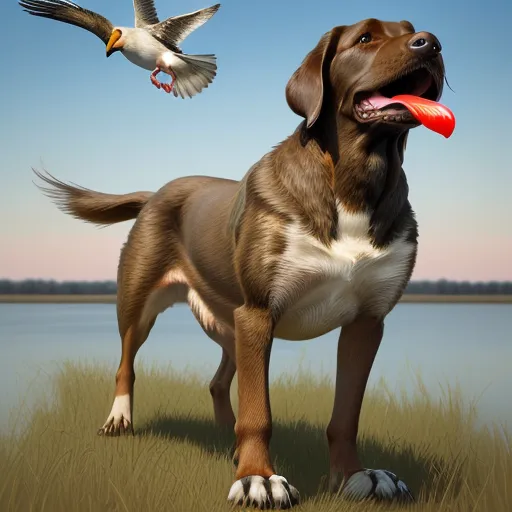
Their friendly and loyal nature is another hallmark of large hunting dog breeds. They often bond deeply with their owners and are eager to please them, making training them for hunting tasks more manageable. Additionally, their unique coats, such as the Curly-Coated Retriever’s curly hair, help protect them from harsh weather conditions. Overall, these breeds combine strength, skill, and a devoted temperament, making them invaluable hunting partners and loyal family companions.
Hunting Abilities and Specializations ;
Large hunting dog breeds have unique hunting abilities and specializations that set them apart in the field. These breeds are renowned for their strength and stamina, making them excel at tracking and retrieving game over long distances. For example, breeds like the German Shorthaired Pointer are versatile, skilled at pointing and retrieving, while the Bloodhound is exceptional at following scent across challenging terrain.
Their size and stamina make them ideal for hunting larger game such as deer or wild boar, where physical strength is important. For example, the Rhodesian Ridgeback was originally bred to hunt lions, demonstrating their courage and strength.
In addition to their physical abilities, many large hunting dogs have special skills. The Chesapeake Bay Retriever, with its water-resistant coat, is excellent at catching waterfowl even in cold, rough water. On the other hand, the Vizsla is a versatile hunter that performs excellently on both land and water, making it a good choice for a variety of hunting situations.
Overall, these large hunting dog breeds are valued for their impressive abilities, from tracking and retrieving to handling difficult terrain, making them invaluable partners for any hunter.
Training and Care for Large Hunting Dogs ;
Large hunting dog breeds require special attention to training and care to ensure they thrive and perform at their best in the field. When training these dogs, consistency and patience are important. Start with basic commands and gradually introduce hunting-specific skills like tracking and retrieval. Positive reinforcement works well, as larger hunting dogs are eager to please and respond well to rewards and praise.
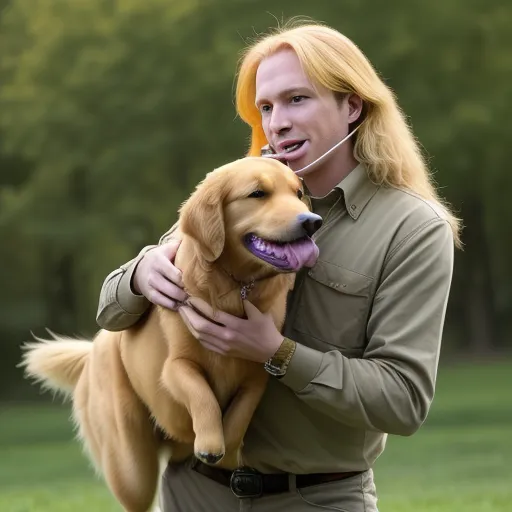
Proper exercise is important to keep large hunting dogs healthy and ready for action. Regular walks, runs and sports sessions help maintain their physical condition and mental stimulation. Incorporate activities that mimic hunting scenarios to keep your skills sharp.
Grooming is another important aspect of care. Breeds such as the Curly-Coated Retriever require regular brushing to manage their distinctive curls and prevent matting. For those with short coats, such as the Labrador Retriever, occasional brushing and bathing is sufficient.
Nutrition is also important. Large hunting dogs require a balanced diet to support their high energy levels and maintain their muscle mass. High-quality dog food tailored to their size and activity level is essential.
Overall, by providing consistent training, adequate exercise, proper care, and a balanced diet, you can ensure that large hunting dog breeds remain healthy, happy, and effective in the field.
Suitability as Family Pets ;
Large hunting dog breeds often prove to be excellent family pets due to their friendly and loyal natures. Despite their size, many of these dogs are gentle and affectionate toward family members, including children. Their energetic and playful behavior means they thrive in active homes where they can get plenty of exercise and attention.
Breeds like the Labrador Retriever and the Golden Retriever are known for their easy-going nature and strong bonds with their families. They generally get along well with children and other pets, making them ideal companions for families. Their desire to please and ability to train also make them well suited to home life.
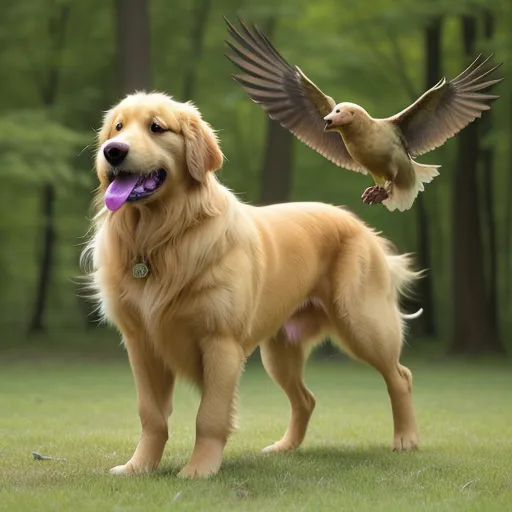
However, large hunting dog breeds require regular exercise to stay happy and healthy. They enjoy activities like running, playing sports, and participating in family outings. Without adequate physical and mental stimulation, they may become bored and develop behavioral problems.
Additionally, their size means they need plenty of room to move around comfortably. Homes with access to a large courtyard or open area are ideal. With the right care, exercise, and attention, large hunting dog breeds can integrate seamlessly into family life, providing both companionship and protection.
** Conclusion **
Large hunting dog breeds offer a unique blend of strength, skill and companionship that makes them stand out as field and family pets. Their impressive physical abilities, including stamina, speed, and specialized hunting skills, make them invaluable partners for hunters. Breeds such as the German Shorthaired Pointer and Labrador Retriever excel at tracking and retrieving, demonstrating their remarkable versatility and dedication.
In addition to their hunting abilities, these dogs bring a lot of love and loyalty to their families. Their friendly and affectionate nature, combined with their playful energy, makes them great companions for active families. They often get along well with children and other pets, adding joy and vibrancy to family life.
However, owning large hunting dog breeds requires a commitment to their exercise needs, training, and grooming. Making sure they get enough physical activity and mental stimulation is important for their well-being. With the right care, these dogs can seamlessly transition from the hunting field to family life, providing both protection and unwavering companionship. In short, large hunting dog breeds offer a perfect blend of skill, loyalty, and family-friendly qualities.
You might be interested in reading this post as well brown hunting dog breeds
**”The Powerhouses of the Hunt: Exploring the Majestic Large Hunting Dog Breeds”** ** Introduction to large hunting dog breeds ** When it comes to hunting, having the right companion with you can make a big difference, and this is where large hunting dog breeds come in handy. These dogs are powerhouses of the hunting world,…
You can read this post https://tomeshnews.co.in/hound-dog-breeds-large/?amp=1
What makes large hunting dog breeds suitable for both hunting and family life?

Large hunting dog breeds combine physical strength and endurance with friendly, loyal temperaments. Their natural hunting skills, such as tracking and retrieving, are complemented by their affectionate nature, making them excellent companions for active families.
How much exercise do large hunting dog breeds need?
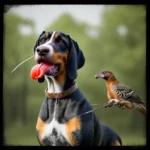
These breeds require significant exercise to stay healthy and happy. Regular, vigorous activities like long walks, runs, and playtime are essential. They thrive in environments where they can engage in both mental and physical stimulation.
Are large hunting dog breeds good with children and other pets?
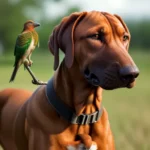
Yes, many large hunting dog breeds like the Labrador Retriever and the Golden Retriever are known for their gentle and friendly nature with children and other pets. Proper socialization and training helps ensure that they interact well within the family.
What kind of grooming do large hunting dog breeds require?
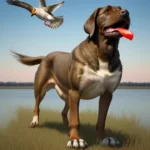
Grooming needs vary by breed. Some, like the Curly-Coated Retriever, require regular brushing to maintain their coat, while others need less frequent grooming. Regular baths, brushing, and checking for parasites are important for all.
How can I ensure my large hunting dog breed stays healthy?
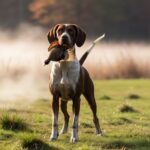
Provide a balanced diet, regular exercise, routine veterinary check-ups, and adequate grooming. Also, engaging them in activities that match their hunting instincts can keep them physically and mentally stimulated.
